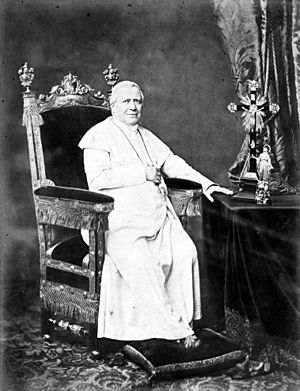Syllabus of Errors facts for kids
The Syllabus of Errors is a special document released by the Holy See (the Pope's main office) on December 8, 1864. It was added to another important letter called the Quanta cura encyclical. This document listed 80 ideas that Pope Pius IX believed were wrong or against Catholic Church teaching. It helped explain the Church's views on many important topics in philosophy and politics at that time.
The main goal of the Syllabus was not to explain everything in detail. Instead, it briefly described each "error" and pointed to other official Church documents that explained them more fully. To truly understand the Pope's message, people needed to read those other documents.
Contents
A Look Back: The Syllabus of Errors
On December 8, 1864, which is the Feast of the Immaculate Conception, Pope Pius IX released the Syllabus of Errors. This document was a collection of ideas that the Catholic Church saw as wrong or heretical in areas like philosophy and politics. It listed these ideas and referred to older Church papers that had already discussed them.
What the Syllabus Was About
The Syllabus was made up of sentences and ideas taken from earlier documents written by the Pope. It listed these "condemned ideas" and showed where they came from. The Syllabus itself didn't explain why each idea was wrong. It just pointed to the older documents that had already done so.
The Syllabus was divided into ten main parts, listing 80 ideas that were considered errors. These ideas covered many different topics:
- Ideas about God, nature, and human reason (like pantheism and rationalism).
- Ideas that said all religions are equally good (called indifferentism).
- Ideas like socialism, communism, and secret societies.
- The rights and power of the Catholic Church, including its control over the Papal States.
- How civil society (the government and people) should relate to the Church.
- Ideas about what is right and wrong (ethics).
- Christian marriage.
- The Pope's power to rule the Papal States.
- Different forms of liberalism in politics.
How People Reacted
The Syllabus caused a lot of discussion and different reactions from people.
Views from Outside the Catholic Church
In 1874, a British politician named William Ewart Gladstone wrote a paper called The Vatican Decrees in their bearing on Civil Allegiance. He argued that after the Syllabus, a person could not become Catholic without giving up their freedom to think and their loyalty to their country. He believed it made people more loyal to the Pope than to their own nation.
Views from Inside the Catholic Church
Some Catholic thinkers, like Félix Dupanloup and John Henry Newman, said that many people misunderstood the Syllabus. They believed that people who didn't read the original documents it referred to were missing the full picture. The ideas listed were condemned as wrong only in the way and context they were originally stated. Without that original context, the document seemed to condemn more ideas than it actually did.
Newman explained that the Syllabus itself didn't have the highest "dogmatic force" (meaning it wasn't a new, strict teaching on its own). He said it was more like an index or a guide. To truly understand it, people needed to look at the original speeches and documents the Pope had made. He also noted that the Syllabus didn't always use the Pope's exact words when describing the errors.
For example, regarding idea #77, which seemed to condemn liberalism, historian E. E. Y. Hales explained that the Pope was not talking about a general rule for all places. Instead, he was expressing his "wonder and distress" about a specific situation in Spain. In Spain, there was a proposal to remove the Catholic Church as the official state church and treat all religions equally. This was not common practice at the time, even in Protestant countries.
After the document was released and caused debate, Pope Pius IX himself called it "raw meat needing to be cooked." However, some within the Church who supported the Syllabus believed there was no misunderstanding. They saw the Syllabus as a clear stand against liberalism, modernism, moral relativism, and the idea of separating government from the Church.
What Happened Next
Later, in 1873, Pope Pius IX wrote another important letter called Etsi multa. In this letter, he continued to share similar thoughts. He spoke out against new laws in South America that were against the Church, calling it a "ferocious war on the Church."
In 1907, another document called Lamentabili sane exitu was released. This was also a "Syllabus" that condemned errors, but this one focused on ideas from scholars who studied the Bible in new ways.
See also
 In Spanish: Syllabus para niños
In Spanish: Syllabus para niños


